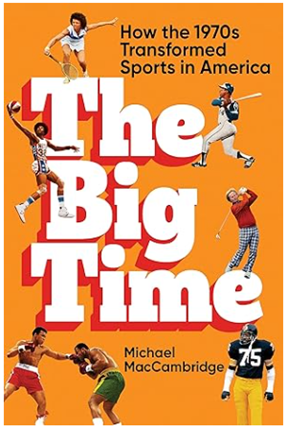The Big Time. Michael MacCambridge.
How the 1970’s Transformed Sports in America.
It is easy to take watching spectator sports for granted due to its omnipotent media coverage these days via network television, cable, streaming, and internet connection platforms. Players commanding and receiving excessive compensation draw perpetual sneers from fans. Even sports discussion via print media, social media and television keeps the topics and action foremost in our minds around the clock daily and yearly. It is enough to pontificate where sports stand as not only a past time in the 21st century but also how it reached the current seemingly overly-saturated status.
In his latest book, The Big Time, esteemed author Michael MacCambridge attempts to argue the changes in just about every major sport that was played in the 1970’s and its impact on how we view and see sports today. MacCambridge, the author of several books including His Life’s Work (Chuck Knoll), did extensive research, and writing (book is about 400 pages in length), to tell his version of this fascinating story.
Inside, readers will encounter stories of just about every major sport played during that decade including pro football, basketball, baseball, hockey, college football and basketball, Professional tennis, golf, boxing and women’s college sports. The reader will also be introduced, exposed and entrenched with topics ranging from player compensation, merger of leagues, Title IX, women’s equality in sports and players taking more control over their value and worth.
The topics connected with free agency particularly with baseball were pretty noteworthy and gripping. The author, through his research, puts former lawyer and player union leader, Marving Miller as the driving force behind wresting more control of power from the owners to the players during the decade via his own skillful leadership and insightful analysis. The same was true in other professional leagues including football and basketball as well. Even in individual sports such as tennis, golf and boxing, the changes of style and attitude were clear among stars such as Jack Nicklaus, Billie Jean King and Muhammed Ali.
Another key figure in the book and one that wielded much influence was former head of ABC sports, Roone Arledge. His vision, ability and willingness to recognize that television could bring just about any and all sports to a greater and more lucrative platform was truly one of the most effective agents of change towards all of sports during that decade. Whether it was the advent of Monday Night football, Wide World of Sports or Challenge of the stars, they were hits and drew more exposure to sports in general that were not available in past generations. And this was just network television. Beyond ABC, and by the end of the decade, NBA games, especially playoffs, were no longer found on tape-delay. Through tough negotiations, the NCAA ultimately allowed teams to be televised more than just a few times per season and the NFL capitalized on this coverage trend by expanding regular season schedules. MacCambridge makes strong connections between the explosion of sports via media as cable television became more prominent in our households especially once ESPN emerged later in the decade.
With a rangy, lengthy book will come topics that go excessively deep in the minutia. One example was the coverage of women’s college sports. In particular, MacCambridge wrote about the many different associations that managed the female varsity teams in the 1950’s, 60’s and into the 70’s. It was inspiring to read about the women coaches and administrator’s that fought tirelessly for the betterment of their sport, yet could also be challenging reconciling acronyms such as the AIAW over the others such as CIAW, or DGWS. While the emergence of Title IX in the early 1970’s changed things for some current and many future female athletes, the topic felt over detailed when re-visited throughout many different sections of the book. Through much debate and divide, the NCAA, led by Walter Byers, ultimately took over the governance of women’s college sports helping to augment greater budgets, scholarships and coverage.
So, does the author succeed in his 400-page argument? Certainly, the facts, the stories and the timelines put this manuscript in a good light. It is not at all a difficult stretch to look at where sports are now as a pillar in our society and strongly tie it back to the numerous transactions that took place during the “me decade”. The author argues that sports may have been looked at as a form of occasional entertainment prior to the 1970’s. But now viewed as a symbol of personification and identity. It likely has been so since the days of disco thanks to the emergence of free agency, more television opportunities, growing fan interest and female athletes given more opportunity. MacCambridge probably could have argued how just a few of the major sports helped generate this transformation. However, that likely would not have told the whole story and the author provides bonus coverage and connection to the rest as well. Sport has hit the big time, and has for awhile now, and this book celebrates that in one intense package.
· You might like this book if you are fan of 1970’s sports.
· You might like to read this book if you enjoy reading about a variety of sports.
· You might like to read this book if you seek information about sports history.
· You might like to read this book if you want to know more about title IX and women’s college sports.
·
Read more about the author on Twitter: https://twitter.com/MacCambridge

Comments
Post a Comment